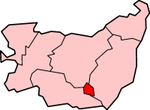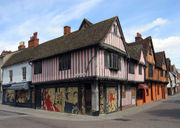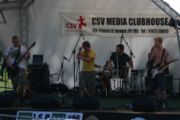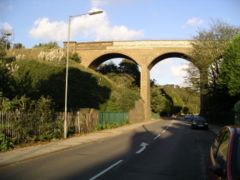Ipswich
2007 Schools Wikipedia Selection. Related subjects: Geography of Great Britain
| Borough of Ipswich | |
|---|---|
 Shown within Suffolk |
|
| Geography | |
| Status: | Borough |
| Region: | East of England |
| Admin. County: | Suffolk |
| Area: - Total |
Ranked 320th 39.42 km² |
| Admin. HQ: | Ipswich |
| ONS code: | 42UD |
| Demographics | |
| Population: - Total (2005 est.) - Density |
Ranked 169th 118,200 2,998 / km² |
| Ethnicity: | 93.4% White 1.8% S.Asian 3.6% Afro-Carib. Other 1.2 |
| Politics | |
 Ipswich Borough Council http://www.ipswich.gov.uk/ |
|
| Leadership: | Leader & Cabinet |
| Executive: | Conservative / Labour / Liberal Democrats |
| MPs: | Michael Lord, Chris Mole |
Ipswich is the county town of Suffolk and a non-metropolitan district in East Anglia, England on the estuary of the River Orwell. It has a population of approximately 140,000 inhabitants (est. 2006) and is the third-largest town in the UK's East Anglia region, and the 38th largest urban area in England.
History
Ancient Ipswich was successively a Stone Age, Iron Age, Roman, and Anglo-Saxon settlement known as "Gippeswick".
The area around Ipswich, or Gippeswick, was sparsely settled until the withdrawal of the Romans. Afterward, its position as a convenient harbour on the North Sea made it convenient to Saxon settlers, and it is claimed to be the first Anglo-Saxon town. The kingdom of East Anglia was for a time centered around Ipswich.
The Ipswich Museum houses replicas of the Mildenhall Treasure and the Sutton Hoo treasure, as well as Saxon weapons and jewellery.
King John granted it its first charter in 1200, and in the next four centuries it made most of its wealth trading Suffolk cloth with the Continent.
During the Middle Ages the Marian Shrine of Our Lady of Grace was a popular pilgrimage destination, and attracted a number of royal pilgrims. The statue was taken away to be burned, although it is now believed to have survived and still to exist in Nettuno, Italy.
Around 1380, Geoffrey Chaucer satirised the merchants of Ipswich in the Canterbury Tales.
Thomas Cardinal Wolsey, the son of a wealthy landowner, was born in Ipswich about 1475. One of Henry VIII's closest political allies, he founded a college in the town in 1528, which is now known as Ipswich School. He remains one of the town's most famed figures.
In 1555, the Ipswich Martyrs were burnt at the stake for their Protestant beliefs. A monument commemorating this event now stands near the scene of their Martyrdom in Christchurch Park.
From 1611 to 1634 Ipswich was a major centre for emigration to New England. This was organised by the Town Lecturer, Samuel Ward. His brother Nathaniel Ward was first minister of Ipswich, Massachusetts.
Ipswich had a racecourse which ran a mix of flat and National Hunt races from 1710 to 1911.
The painters John Constable and Thomas Gainsborough lived and worked in Ipswich. In 1835, Charles Dickens stayed in Ipswich and used it as a setting for scenes in his novel The Pickwick Papers. The hotel where he resided first opened in 1518; it was then known as The Tavern and is now known as the Great White Horse Hotel. Dickens made the hotel famous in chapter XXI of The Pickwick Papers, vividly describing the hotel's meandering corridors and stairs.
In 1797 Lord and Lady Nelson moved to Ipswich, and in 1800 Lord Nelson was appointed High Steward of Ipswich.
Politics
Ipswich is governed locally by a two-tier Council System. Ipswich Borough Council which fulfils District Council functions such as refuse collection, housing and planning and Suffolk County Council which provides services such as education and social services.
Between 1979 and September 2004 Ipswich Borough Council was under Labour Control but the town is now governed by a coalition of Conservative and Liberal Democrat Councillors with Labour in opposition.
The County Council was controlled by a Labour/Liberal Democrat administration between May 1993 and May 2005 but has since reverted to Conservative Control. This is despite the fact that 10 out of the 13 County Councillors representing Ipswich are Labour and only 1 is a Conservative.
In April 2006 the local borough council initiated public discussions about the idea of turning the borough into a unitary authority. Ipswich had constituted a county borough from 1889 to 1974, independent of the administrative county of East Suffolk, and this status was not restored by the Banham/Cooksey Commission in the 1990s. Ipswich, Norwich, Exeter and Oxford have united to campaign for unitary authority status for the four towns. Ipswich hopes to use the window of opportunity presented by the October 2006 Local Government White Paper to regain unitary status.
The town is covered by two parliamentary constituencies - Ipswich which covers about 75% and is represented by Labour MP Chris Mole, and Central Suffolk & North Ipswich which covers the remaining 25% and is represented by Conservative MP Michael Lord.
Modern Ipswich
The former airport has been re-developed into the new residential district of Ravenswood. However, the front of the control building was saved. It was designed by Heining and Chitty in 1938 and Grade 2 listed. The rest of the building was taken down after it was deemed unsafe to reuse.
Modern figures with Ipswich connections include the musician Nik Kershaw, the children's TV presenter Brian Cant, the punk rock band The Adicts, heavy metal band Cradle of Filth, cartoonist Carl Giles and Formula One owner Bernie Ecclestone.
Tolly Cobbold Brewery, built in the 19th century and rebuilt 1894–1896, is one of the finest Victorian breweries in the United Kingdom. There was a Cobbold Brewery in the town from 1746 until 2002 when Ridley's Breweries took Tolly Cobbold over. Felix Thornley Cobbold presented Christchurch Mansion to the town in 1896.
Ipswich Centre contains the all-glass building owned by Willis Limited, properly called the Willis Building but still often called the "Willis-Faber building" by locals, as the company Willis Corroon themselves used to be called Willis Faber. Designed by Norman Foster, the building dates from 1974. It became the youngest Grade I listed building in Britain in 1991, ironically standing right next to one of the oldest extant buildings in Ipswich, the Unitarian Meeting House, which is also Grade I listed.
Ipswich is the last place in the area to have an independent bus company which has the unusual practice of naming its buses.
Ipswich has undergone an extensive gentrification programme in recent years, principally centred around the waterfront. Though this has turned a derelict dock area into an emerging residential and commercial centre, it is being completed at the expense of much of the town's industrial and maritime heritage and in spite of efforts made by a local group, The Ipswich Society. Much of this development is residential and is marketed at high net-worth individuals in the DINKY demographic. As such, some have considered it incompatible with Ipswich's existing socioeconomic mix. It could therefore be considered to be aimed at encouraging economic migration to the town, particularly as a commutable satellite town of London.
Holywells Park is a 67 acre (27 ha) public park, situated near the docks, that was painted by Thomas Gainsborough.
Ipswich is set to be the main hub for University Campus Suffolk, which will give Suffolk its first university.
'Chantry' is the name of a housing estate and park, located in Ipswich, in East Anglia within England. Its schools include Chantry High School and the Chantry Infant and Junior Schools which have merged, and been renamed 'The Oaks'.
Culture
Like many other similar towns, Ipswich is home to many artists, with galleries at Christchurch Mansion, the Town Hall, a gallery in the Ancient House and the Artists Gallery in Electric House being the more prominent. The visual arts are further supported with many sites of sculpture with easy accessibility a list of which is on The Wolsey Gallery's website. The Borough Council promotes creation of new public works of art and has been known to make this a condition of planning permission .
Performing arts are well represented with Ipswich being home to DanceEast which has the primary aim of advocating innovation and development of dance in the East of England . They are building new premises as part of the waterfront development, these will be the first custom built dance facilities in the East of England at a cost of around £8million.
Since 1991, there has been an annual arts festival called Ip-Art which brings together many events across art disciplines and different venues, notably a free music day in Christchurch Park, which in 2006 had over 50 different acts performing over 7 stages.
Industry
Industry around Ipswich has had a strong agricultural bias with Ransomes, Sims & Jefferies Ltd, one of the most famous agricultural manufacturers, located in the town. There was a sugar beet factory at Ipswich for many years; it was closed in 2001 as part of a rationalisation by British Sugar.
The British Telecom Research Laboratories were located to the east of the town in 1975 at Martlesham Heath. They are now a science park called Adastral Park.
Transport infrastructure
Ipswich railway station is located on the Great Eastern Main Line from London Liverpool Street to Norwich. It is also the junction of railway lines to Felixstowe and Lowestoft. The station is served by 'one'.
The Ipswich trolleybus system opened on 2 September 1923 and closed on 23 August 1963.
Ipswich is still a flourishing port, handling several million tonnes of cargo each year.
The town used to feature a small grass-runway airport ( ICAO code: EGSE). Officially opened on 26 June 1930 by His Royal Highness the Prince of Wales. There were regular flights in the early days by Channel Airways to Jersey and later Suckling Airways to the Netherlands. On 31 December 1996 Ipswich Airport was delicensed, and ceased to be registered by the Civil Aviation Authority. The land is now used for the Ravenswood estate.
Ipswich is served by a mature road network. Key roads include the A12, A14, A1156 and the A1214.
Sport
Ipswich is very proud of its football team, Ipswich Town Football Club, who were established in 1878 and play at the 30,000 capacity Portman Road Stadium. They have a strong rivalry with Norwich City F.C.. Ipswich Town was home to two successful England managers, Sir Bobby Robson and Sir Alf Ramsey. They won the FA Cup in 1978 and the UEFA Cup in 1981 under Robson and currently play in English football's second-tier league, the Football Championship.
Ipswich also has a very successful Speedway team, the Ipswich Witches, who have ridden at their Foxhall Stadium home, on the outskirts of Ipswich, for over 50 years. Despite being one of the most successful teams in British Speedway history crowds have dwindled to around 1,500 people per race meeting.
Famous residents
- Brian Cant - Children's TV Presenter (Notably Camberwick Green and Trumpton)
- Kieron Dyer - Midfielder for Newcastle United (1999-Present) and ex- Ipswich Town player (1996-1999)
- Sir Trevor Nunn CBE - Stage and Film Director. Director of the Royal Shakespeare Company for 18 years (1968-1986)
- Jenny Platt - Actress best known for her role as barmaid Violet Wilson in the long running ITV soap, Coronation Street
- Sanchez - Sir Topham Hat



